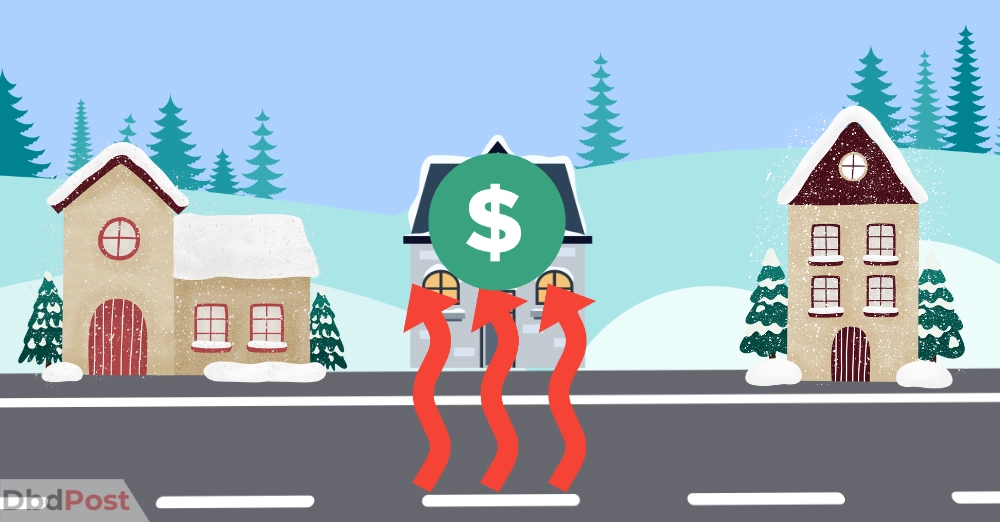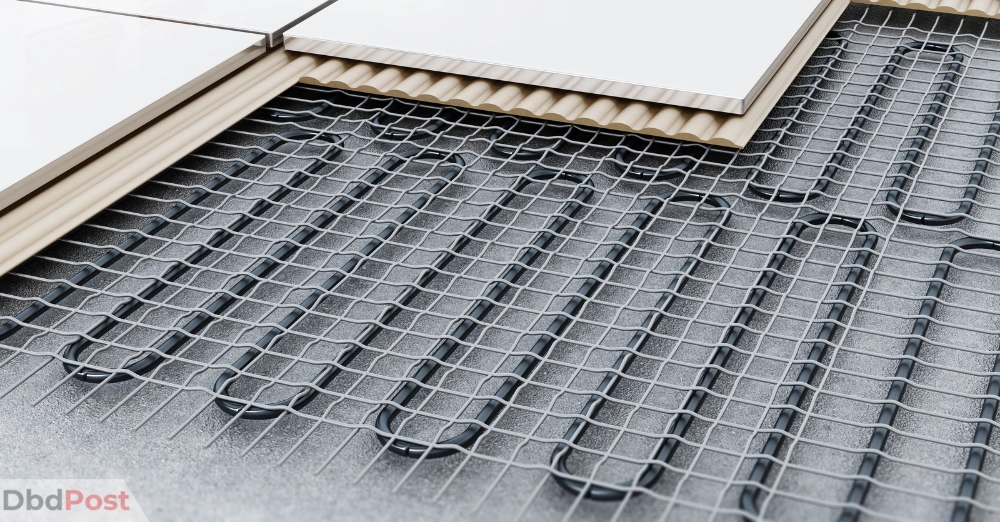Imagine waking up on a winter morning and stepping outside to find that your driveway is already free of snow and ice. No need to bundle up and brave the freezing temperatures to shovel or salt your driveway. A heated driveway will take care of it.
A heated driveway is a driveway that is equipped with a heating system that melts snow and ice keeping it clear. The average heated driveway cost is $6,000, with most heated driveways costing $3,600 – $11,750.
This article will provide an overview of the cost of a heated driveway. It will provide information on getting the best suitable and affordable heated driveway.
Average heated driveway cost

A heated driveway’s installation cost, which covers materials and labor, can range from $3,600 to $11,750.
The actual price per square foot or linear foot will differ depending on several factors, such as the type of system employed, the driveway’s size, and the property’s location.
Typically, heated driveways are priced between $12 and $23 per square foot, but this can vary significantly based on the specific circumstances.
Maintenance costs
When you get a heated driveway, there will be some fees you have to pay. But it is also essential to think about the cost of running it. This cost for heated driveway changes depending on where you live and how much electricity costs in your area.
Most people in the United States pay more than $0.14 per kilowatt hour for electricity. Call your electric company or look at your bills to know how much you pay. [1] EIA, Electric Power Monthly, https://www.eia.gov/electricity/monthly/epm_table_grapher.php?t=epmt_5_6_a ref
Electrical systems usually only need a little maintenance. However, it is wise to save money for any repairs required. This includes replacing boards or fixing holes in the tubes.
You may need to hire an electrician who typically charges $40 to $100 per hour or more for repair.
It’s important to note that heated driveways are complex, and if the repairs require tearing up the driveway, your expenses can increase significantly.
Factors affecting heated driveway cost
The price for a heated driveway will be different each time. It depends on the heating system, the driveway’s size, and location.
Here are some examples of how these factors can impact the overall cost of a heated driveway:
Type of heating system
There are various types of heating systems that you can install. The most common ones include electric, hydronic, and radiant heating systems, each with unique benefits and drawbacks.
One option is an electric heating system. This system is relatively inexpensive to install, making it a popular choice among homeowners. However, it may be costlier to operate over time due to high electricity consumption.
Another option is a hydronic heating system that uses hot water or glycol to heat the driveway. While this system may be more expensive to install, it can be more efficient and cost-effective in the long run. It also provides a more consistent heating experience as it does not rely on electricity to generate heat.
The third option is a radiant heating system, considered the most efficient and even heating option. It uses a series of tubes or wires installed beneath the driveway to distribute heat evenly. However, it has a higher installation cost than the other two options.
Driveway size

The size of the driveway is another important factor that impacts the heated driveway installation prices.
Larger driveways will require more heating elements and materials, which can increase the overall cost.
Location
The property’s location can influence the cost of installing a heated driveway.
Moreover, the overall cost of labor and materials involved in the installation process can vary based on the local market.
For example, properties in colder climates or areas with more snowfall may require more heating elements and a more powerful heating system, which increases the heated driveway pricing.
Therefore, it is crucial to consider the property’s geographical location while estimating the expenses of installing a heated driveway.
Installation process

The steps involved in installing a heated driveway are as follows:
Step 1: Remove the existing driveway/sidewalk
To install a heated driveway, the initial step involves removing the existing driveway or sidewalk where the heating system will be installed.
This process may require breaking up concrete or asphalt driveways and hauling the debris. Ensuring the area is entirely cleared before proceeding to the next step is crucial.
This is essential to avoid any potential issues later in the installation process.
Step 2: Ensure the soil below is compact
After the removal of the current driveway or sidewalk, it’s crucial to ensure that the soil underneath is firmly packed to provide a stable and strong base for the upcoming driveway.
For this purpose, a compactor machine is typically used to press the soil down and eliminate any air pockets.
This process forms a compact and solid foundation essential for a durable and long-lasting driveway.
Step3: Connect and install the heating elements
After determining the layout plan for warming the driveway, the next crucial step is to lay out the heating elements or cables.
This process involves carefully positioning the cables in the desired pattern and connecting them to the control unit. To ensure everything is installed correctly, following the manufacturer’s instructions attentively is crucial.
By doing so, the heating elements or cables can function optimally, providing efficient warmth to your driveway.
Step 4: Pour the concrete
After installing and connecting the heating system, the next step is to pour concrete or lay asphalt over it. This process is typically carried out using a paving machine to ensure the material is evenly spread across the entire area.
Once in place, the material must be smoothed and leveled with a trowel or a similar tool.
Once the concrete or asphalt has dried and cured, the heated driveway is ready for use.
Benefits of a heated driveway
Heated driveways offer several benefits to homeowners, including:
Safety
A heated driveway melts snow and ice, reducing the risk of slip-and-fall accidents. This is particularly important for older people, children, and individuals with mobility issues.
Convenience
A heated driveway can make winter easier. You don’t have to shovel snow or put salt down. This is helpful for people who are too busy or can’t do those tasks because of their health.
Property value
A heated driveway can increase the value of a property, particularly in regions with harsh winter weather. This feature is often attractive to potential homebuyers and can make a property stand out in a competitive real estate market.
Longevity
A heated driveway will help make the pavement last longer. It melts snow and ice, which prevents damage to the driveway. This can save money on repairs.
Energy efficiency
Sometimes, a heated driveway can be more energy-efficient than snow removal methods, such as snow blowers or plows. This is particularly true for hydronic systems, which use less electricity than their electric counterparts.
Cost-saving tips
Choose a budget Saving option
One option to save money on the cost of a heated driveway is to purchase heated mats and place them in the tire tracks where you will be driving in and out.
This is more budget-friendly than having a professional contractor install a radiant heating system into your driveway surface.
Heated driveway mats cost anywhere from $145 for a 20-inch x 60-inch mat to $700 to $1,500 for larger mats.
DIY options
Consider purchasing heating mats and placing them in the tire tracks where you drive in and out. This will be a budget-friendly way to heat your driveway.
However, remember that DIY installation may be less effective than a professionally installed system.
Timing the installation
Install a heated driveway when constructing a new home or replacing an existing one. This saves on installation costs and reduces the amount of retrofitting required.
Selecting the right contractor
Research contractors and compare quotes from multiple contractors to find the best deal.
Look for experienced and licensed contractors who can provide references and have a good reputation in the industry.
Consider energy efficiency
Select a heating system that is energy efficient to reduce long-term operating costs. Hydronic systems, for example, are more energy-efficient than electric systems and may save you money in the long run.
The Fuel Assistance Program
The Fuel Assistance Program is a part of the federal Low Income Home Energy Assistance Program, supported by the US Department of Health and Human Services.
Once available, this program provides financial assistance to eligible households across New Hampshire to help cover their heating costs. Fuel Assistance benefits range from $304 to $3,024, depending on household income and energy costs. [2]Energy, Fuel Assistance Program, … Continue reading
Related Info
- Find out everything about Brazilian Laser hair removal cost with our guide.
- Discover Mole Removal Cost with our guide and never worry about them in the future.
- Find out everything about hair transplant cost with our guide.
- Check our guide for everything you need to know about Root canal cost.
- Learn how much does it cost to start an LLC with our guide – here.
FAQs
How does a heated driveway work?
A heated driveway works by installing a heating system beneath the pavement. This sends heat through tubes or wires embedded in the surface, melting snow and ice to clear the driveway.
Are there any maintenance requirements for a heated driveway system?
Yes, all heated driveway systems require routine maintenance to ensure they function properly. This includes checking the wiring and connections, inspecting for any signs of damage or wear, and replacing parts as needed.
What type of heating system is most suitable for a heated driveway?
The type of heating system that’s best for a heated driveway depends on the size and shape of the area, as well as personal preference. Electric systems are typically more affordable to install, while hydronic systems are more energy-efficient and heat larger sizes.
Can a heated driveway be installed on an existing driveway?
Yes, in most cases, you can install a heated driveway existing driveway. However, the existing surface must be in good condition and able to support the weight of the heating system.
How long does it take to install a heated driveway system?
The installation time for a heated driveway depends on the size and complexity of the project, as well as the type of heating system used. In most cases, it will take 1-2 days to complete.
Is it possible to control the temperature of a heated driveway system?
Yes, most heated driveway systems have a thermostat that allows you to adjust the system’s temperature. This will help you ensure your driveway is always at the optimal temperature for melting snow and ice.
Installing a heated driveway is an investment that will pay off in the long run. Although the heated driveway cost is initially higher than other snow removal methods, the money saved in energy efficiency and lower maintenance costs will quickly make up.
- 107shares
- Facebook Messenger
About the author
DbdPost Staff is a team of writers and editors working hard to ensure that all information on our site is as accurate, comprehensive, and trustworthy as possible.
Our goal is always to create the most comprehensive resource directly from experts for our readers on any topic.




![How to Cancel Blue Apron: Complete Guide [year] feature image-how to cancel blue apron-cancelling blue apron illustration-01](https://dbdpost.com/wp-content/uploads/2023/06/feature-image-how-to-cancel-blue-apron-cancelling-blue-apron-illustration-01-150x150.webp)